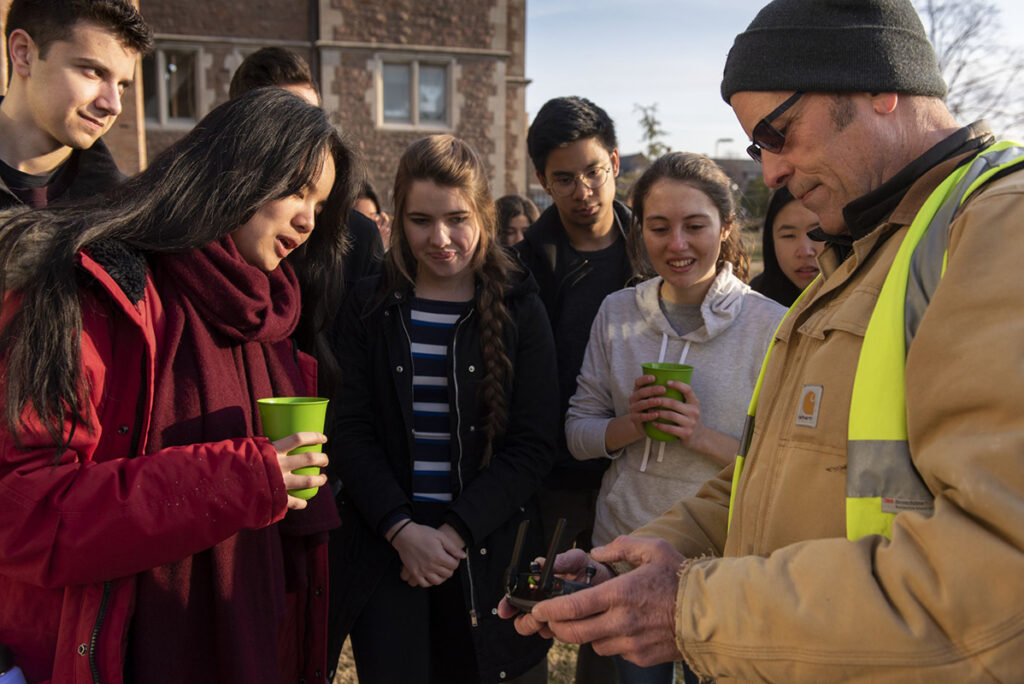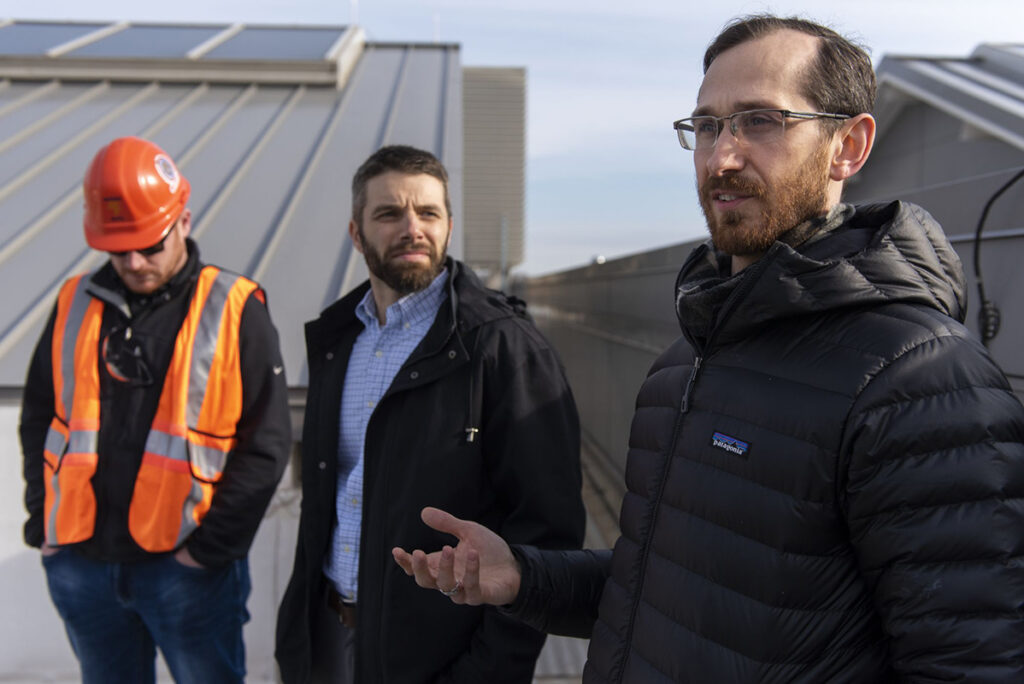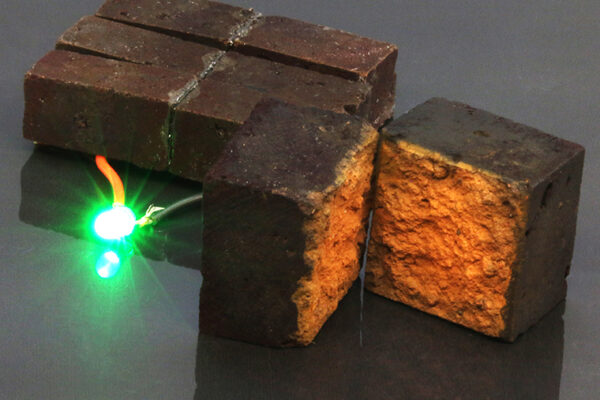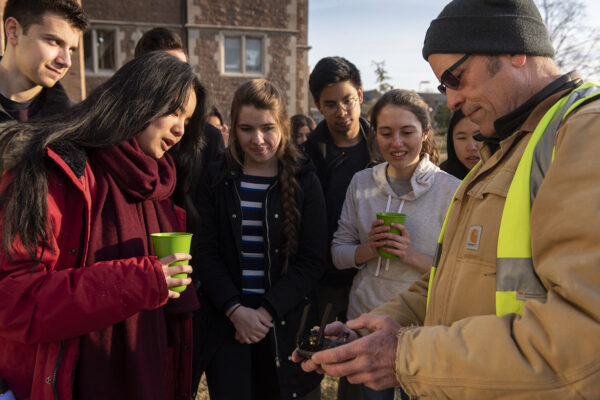
Is solar energy on the South 40 of Washington University in St. Louis feasible?
To answer that one question, the members of RESET, a new program from the Office of Sustainability, had to ask hundreds more.
Can the residential and office buildings of the South 40 support the weight of solar arrays? Do arrays work on a pitched roof? And what about government and university policies which regulate everything from worker safety to architectural aesthetics?
Another big question: Is it worth it? Sure, solar for solar’s sake sends a positive message. But solar that delivers returns requires a sophisticated understanding of available tax credits and rebates, financing plans and local utility costs.
“A lot of people assume that all you need for a successful solar project is sunshine and some panels,” said senior Cole Goldklang, an economics major in Arts & Sciences who will work for GE Energy Financial Services after graduation. “But we learned business, policy and engineering aspects of renewable energy are all interconnected. There are so many variables, each with so many implications.”
RESET (which stands for Renewable Energy Student Engagement Team) was born this year out of sophomore Sophia Dossin’s search for interdisciplinary coursework in renewable energy. A double major studying environmental policy in Arts & Sciences and economics and strategy in Olin Business School, Dossin understood the broad concepts that govern the energy sector. But she wanted to learn specifically about the challenges and opportunities connected to renewable energy. And she wasn’t alone.
“Clean, renewable energy is the future — we know that,” Dossin said. “But what makes a project happen? I had a lot of friends in the green community who knew their corner of the industry but wanted to really understand the entire landscape.”
Dossin brought her idea to Phil Valko, assistant vice chancellor for sustainability, and together they developed RESET as a for-credit experiential learning program. RESET’s 19 students, selected from a large field of applicants, were divided into teams — engineering, policy and business. The students largely taught themselves but also attended lectures on solar engineering, construction, policy and financing from Marc Lopata, president of Azimuth Energy and the university’s partner on its solar expansion project on the Danforth, Medical and North campuses.

“We aim to use our campus as a living laboratory and classroom and RESET is a perfect manifestation of this idea,” Valko said. “RESET was structured with a learning phase and a doing phase, where the students acquired knowledge with an eye towards their final project. The fact that it was the South 40, a place that is or has been their home, made it all the more compelling.”
Kaylene Hung, a dual-degree student studying energy, environmental and chemical engineering in the McKelvey School of Engineering, led the engineering team. Her members studied drone images of South 40 rooftops, evaluated different solar design softwares and met with university facility managers while communicating with the other teams.
“I was really looking for an experience that took me out of the classroom,” Hung said. “All of us came from different starting points, but none of us fully understood the nitty-gritty details of these complicated projects. Learning together was the best part.”
Each new piece of information raised new challenges. For instance, during a meeting with university facility managers, the engineering team learned safety standards may require that the arrays be placed eight feet from the roof’s edge. Originally the team established a four-foot setback in accordance with local fire codes. That news prompted the policy team to research safety guidelines, which can vary depending on the roof. Meanwhile, the business team ran new models to evaluate if a smaller footprint would still be financially feasible.
Still, other factors, such as scheduled roof replacements and the angle of certain roofs, made many buildings poor candidates for solar power. Ultimately, RESET determined that solar on the South 40 is feasible, but only on five of the site’s 40 buildings: Danforth, Liggett, Mudd, Park and Wheeler.
On April 18, students made their pitch to senior university leadership. They urged the university to act now to take advantage take advantage of tax credits that will be stepping down in the coming years, make future construction solar-ready and to consider solar projects at Olin Library and the Psychology Building.
RESET will host a public presentation of its South 40 solar plan at 7 p.m. Wednesday, April 24, in Simon Hall, Room 122.
Though more modest than RESET members had hoped, the proposal still would add 120 kilowatts of solar-generating capacity and save some $500,000 in energy costs during the 20-year life of the arrays.
“This is a fantastic time for the university to expand its solar,” Dossin said. “The incentives and stars are aligned. These solar installations meet the university’s environmental goals and demonstrate its leadership in this issue.”
Leaders were impressed by the students’ expertise and will investigate how RESET’s proposal aligns with the university’s broader efforts to reduce carbon emissions and lead the region as a top producer of on-site solar energy.
“The RESET students’ engagement this semester will not only help Washington University continue to reduce its carbon footprint, it has broader implications for de-carbonizing the grid,” said Valko, who will offer RESET again next semester. “They have acquired skills and knowledge that are the foundation for impactful careers in the growing renewable energy industry.”


